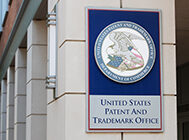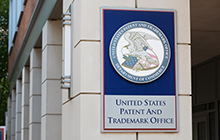 On January 16, 2024, the Patent Trial and Appeal Board (PTAB) of the United States Patent and Trademark Office issued a Final Written Decision in a post-grant review (PGR) (PGR2021-00030) of claims in US Patent No. 10,808,039 (“the ’039 patent”) owned by Seagen. The PGR, filed by Daiichi Sankyo, Inc. and AstraZeneca Pharmaceuticals, LP, requested review of claims 1-5, 9, and 10 of the ’039 patent, which are directed to antibody-drug conjugates (ADC) capable of intracellular cleavage. The ’039 patent is at issue in a patent infringement lawsuit brought by Seagen against Daiichi Sankyo over Daiichi’s FDA-approved ADC cancer therapy ENHERTU®. Previously, a federal jury has found that ENHERTU infringed the ’039 patent and awarded $41.8 million in royalty revenue to Seagen.
On January 16, 2024, the Patent Trial and Appeal Board (PTAB) of the United States Patent and Trademark Office issued a Final Written Decision in a post-grant review (PGR) (PGR2021-00030) of claims in US Patent No. 10,808,039 (“the ’039 patent”) owned by Seagen. The PGR, filed by Daiichi Sankyo, Inc. and AstraZeneca Pharmaceuticals, LP, requested review of claims 1-5, 9, and 10 of the ’039 patent, which are directed to antibody-drug conjugates (ADC) capable of intracellular cleavage. The ’039 patent is at issue in a patent infringement lawsuit brought by Seagen against Daiichi Sankyo over Daiichi’s FDA-approved ADC cancer therapy ENHERTU®. Previously, a federal jury has found that ENHERTU infringed the ’039 patent and awarded $41.8 million in royalty revenue to Seagen.
Issues raised in the PGR included whether claims 1-5, 9, and 10 of the ’039 patent were not patentable for lack of written description and enablement under 35 U.S.C. §112(a), indefiniteness under 35 U.S.C. §112(b), and anticipation under 35 U.S.C. §102.
On the issue of written description, Daiichi argued that the claims were not sufficiently supported because (a) the disclosure lacked descriptive support for the claimed gly/phe tetrapeptide component (Ww) of the ADC, and (b) the disclosure did not describe a representative number of species for the genus of “drug moiety” nor did the disclosure demonstrate common structural features for the “drug moiety” component.
On enablement, Daiichi argued that the ’039 patent does not enable the full scope of the claimed ADCs. Specifically, it noted that “[c]omplex chemical interactions among ADC components affect its structure and properties,” and that “[w]hile the claim does limit one aspect of the linker … the structural limitations of the claim still encompass an astronomical number of structurally and functionally disparate compounds.”
In the Final Written Decision, the PTAB held that claims 1-5, 9, and 10 are unpatentable for failing to comply with the written description and enablement requirements under Section 112(a).
Among its findings for written description, the PTAB determined that the specification of the ’039 patent did not have sufficient written descriptive support for claimed gly/phe tetrapeptide component. Noteworthy, with regards to the “drug moiety,” the PTAB opinion distinguished the Seagen patent from the patent at issue in Juno v. Kite, stating that the ’039 specification disclosed dozens of different known chemotherapeutic agents in multiple classes. Further, the opinion referred to Falko-Gunter Falkner v. Inglis in noting that “the recitation of known structures … ‘would serve no goal of the written description requirement’.” The opinion also stated that “the claims of the ’039 patent are not focused on the particular cancer drugs selected from the large number of known cancer drugs or the antibody used, but rather focus entirely on the linker joining a drug moiety and an antibody or other ligand moiety.”
The PTAB also found that the claims were not enabled. After going through the Wands Factors, the PTAB concluded that undue experimentation would have been required to make and use the claimed invention in view of, for example, the large scope of the ADC claims, the limited working examples and guidance provided by the patent, the unpredictability of the art around ADCs, and the quantity of experimentation needed. The claims were also found to be anticipated under Section 102.
Daiichi’s general counsel issued a statement saying that the company is “pleased” with the PTO’s decision. Seagen issued a statement indicating that it would appeal the decision.

 On January 23, 2024, the U.S. Court of Appeals for the Federal Circuit (“Federal Circuit”) issued its
On January 23, 2024, the U.S. Court of Appeals for the Federal Circuit (“Federal Circuit”) issued its  On December 26, 2023, the United States Court of Appeals for the Federal Circuit issued its
On December 26, 2023, the United States Court of Appeals for the Federal Circuit issued its  On January 16, 2024, the Patent Trial and Appeal Board (PTAB) of the United States Patent and Trademark Office issued a
On January 16, 2024, the Patent Trial and Appeal Board (PTAB) of the United States Patent and Trademark Office issued a  The U.S. Food and Drug Administration (FDA) recently issued a draft guidance, “
The U.S. Food and Drug Administration (FDA) recently issued a draft guidance, “ As the life sciences, medtech, and diagnostic industries continue to expand and grow increasingly complex, so does the legal, regulatory, and compliance landscape. To help companies and investors navigate the many evolving and emerging laws and regulations across pharmaceuticals, biologics, medical devices, diagnostics, and laboratory testing, our Life Sciences Regulatory & Compliance team has provided an overview of key developments. We update and publish a quarterly tracker detailing these developments. You can read about the Q1 2024 updates
As the life sciences, medtech, and diagnostic industries continue to expand and grow increasingly complex, so does the legal, regulatory, and compliance landscape. To help companies and investors navigate the many evolving and emerging laws and regulations across pharmaceuticals, biologics, medical devices, diagnostics, and laboratory testing, our Life Sciences Regulatory & Compliance team has provided an overview of key developments. We update and publish a quarterly tracker detailing these developments. You can read about the Q1 2024 updates